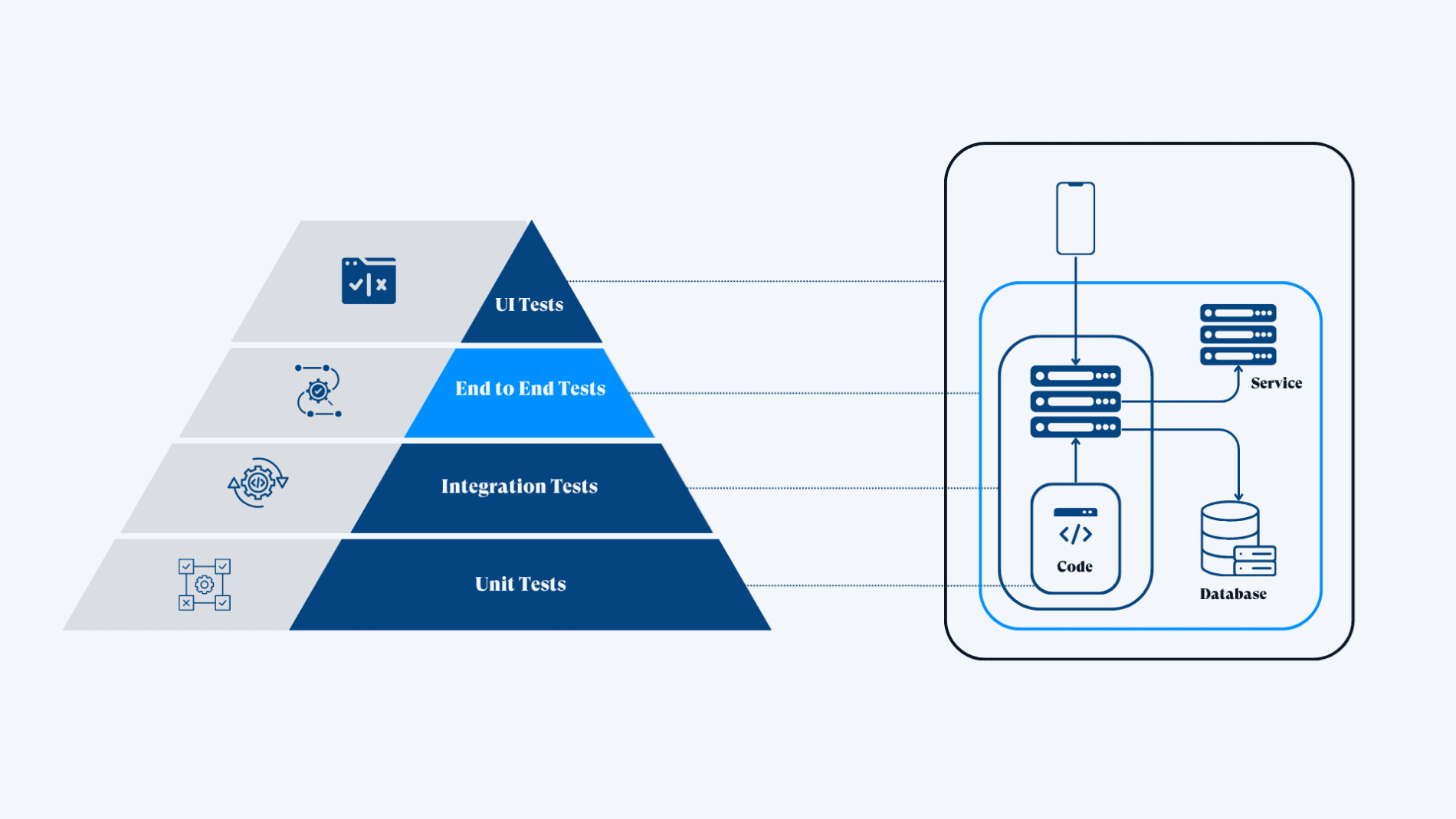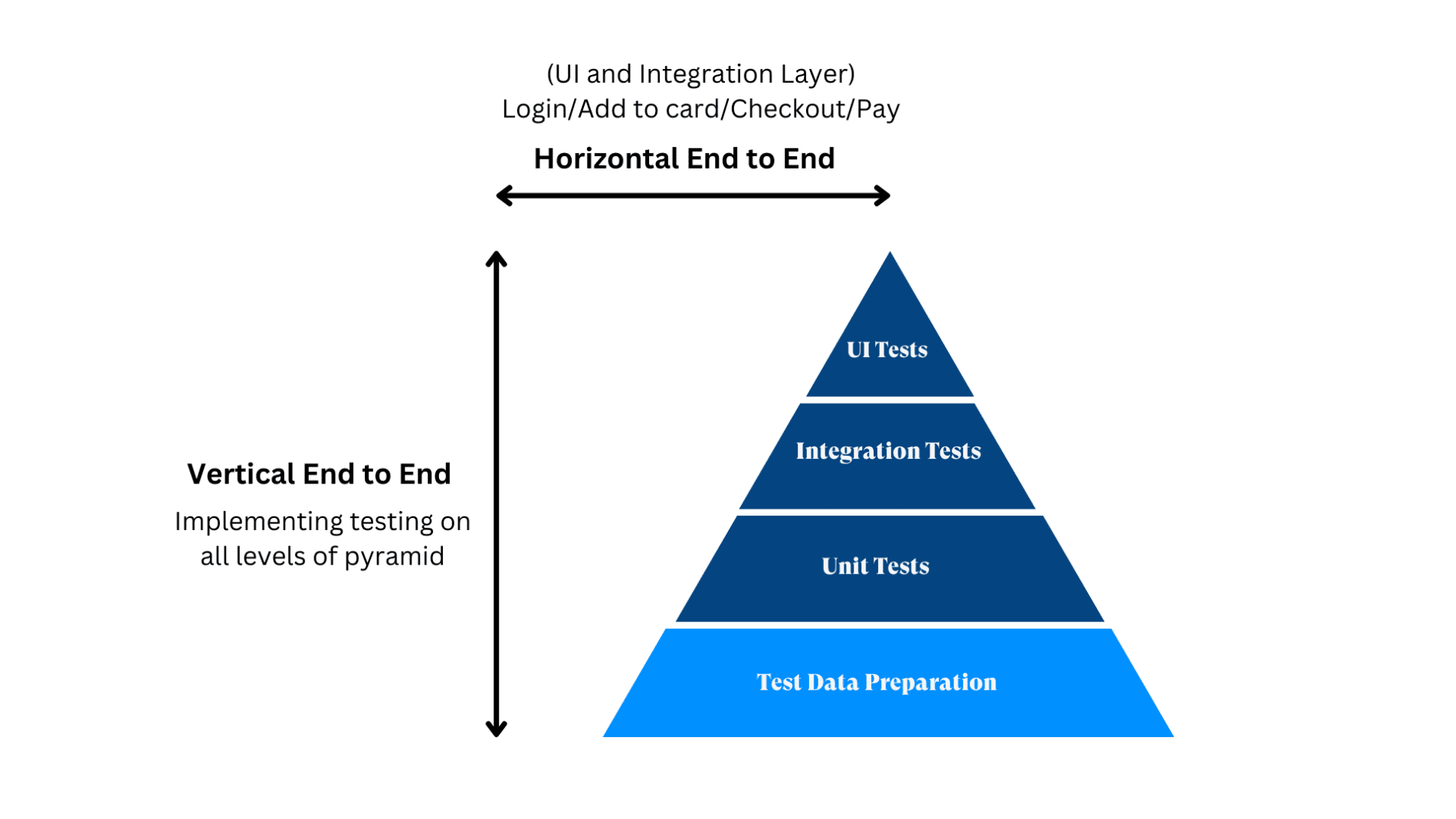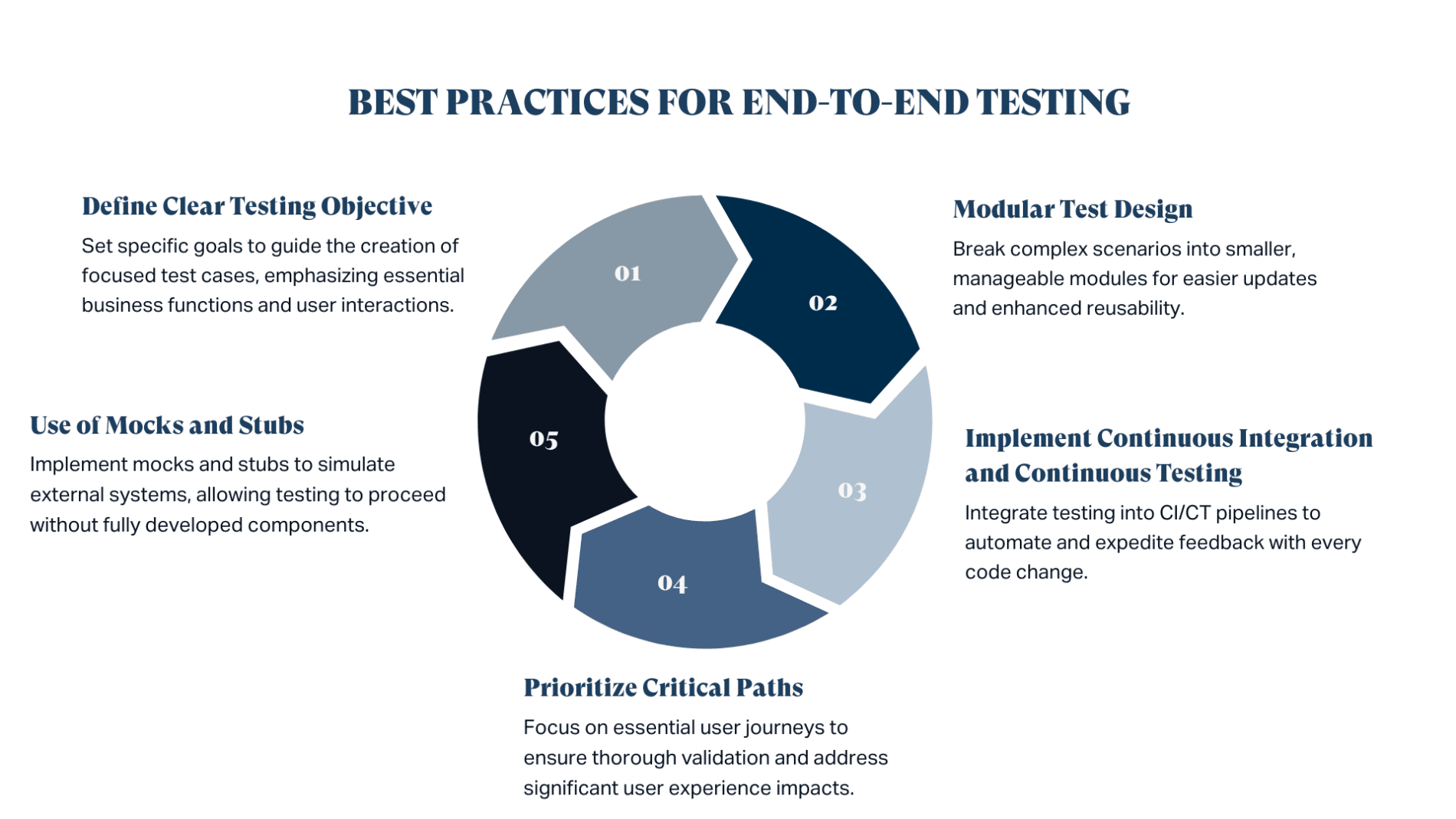End to End Testing: A Complete Guide to E2E
Many organizations struggle with fragmented testing approaches covering only individual components or features, leading to gaps in the system’s reliability and user experience.

This lack of holistic testing can result in critical bugs slipping through production, causing costly post-release fixes and damaging user trust.
End to end (E2E) testing offers a complete solution to this problem by validating the entire application workflow from start to finish. E2E testing ensures that all integrated components of an application work together smoothly, simulating real-world user scenarios.
This article will explore the comprehensive methodology of end to end testing, covering its definition, the three layers (front-end, back-end, and types), and its benefits. We’ll also address the challenges and provide best practices for effective implementation.
Additionally, we’ll discuss popular tools and frameworks, real-world examples, and comparisons with functional and integration testing, leading up to a discussion of how Testlio can be used to execute reliable E2E tests.
Table of Contents
- What is End to End Testing?
- Three Layers of E2E Testing
- Types of End to End Testing
- Benefits of End to End Testing
- Challenges of End to End Testing
- Best Practices for Effective End to End Testing
- Tools and Frameworks for E2E Testing
- End to End Testing Scenario Examples
- End to End Testing vs Functional Testing
- End-to-End Testing vs Integration Testing
- End to End Testing with Testlio
What is End to End Testing?
End to end (E2E) testing evaluates an application’s workflow from beginning to end. It simulates real user scenarios and interactions to ensure the application’s components communicate and work together as expected.

End to end (E2E) testing involves creating a production-like environment to test an application’s compatibility and dependencies. This type of testing covers user interfaces, databases, network communications, and other integrated systems. By replicating real-world user actions, E2E testing helps identify issues that may arise during actual use.
E2E testing verifies data integrity, simulates real-user scenarios, and confirms usability and reliability. It detects system-level issues that might not be caught during unit or integration testing, such as problems with data flow, software interactions, and overall system behavior.
Furthermore, E2E testing is essential because it provides comprehensive coverage and evaluates the entire application thoroughly. It helps with early bug detection by simulating real-world scenarios, reducing the cost and effort of fixing issues later.
This testing improves the overall user experience by validating that the application meets user expectations and performs reliably, building confidence in its stability and readiness for release.
Three Layers of E2E Testing
End-to-end (E2E) testing is a comprehensive approach that examines the various layers of an application for smooth performance. These layers include the front-end, back-end, and infrastructure, each playing a crucial role in the application’s overall performance and reliability.
Front-end
The front-end layer focuses on testing the application’s user interface (UI) and user experience (UX). It involves checking that all visual elements, like buttons, forms, and navigation menus, work correctly and provide a smooth user experience.
The front-end test verifies that the application works across different devices and browsers and is intuitive.
Back-end
The back-end layer involves testing the server-side components, including databases, APIs, and server logic. It helps ensure that data is correctly stored, processed, and retrieved and that the application can handle various requests and transactions effectively.
Back-end testing validates the integrity and performance of the core functionalities supporting front-end operations.
Infrastructure
The infrastructure layer focuses on the underlying hardware and software environment that supports the application. It includes testing the network, servers, and other infrastructure components to ensure they are correctly configured.
A successful infrastructure test ensures the application runs smoothly and reliably in a production environment.
Types of End to End Testing

Horizontal
Horizontal end-to-end testing verifies user workflow across different applications or interfaces. It ensures that the entire process works efficiently across a wide range of systems and platforms.
For example, in an e-commerce application, horizontal testing would involve checking the entire purchase process, from selecting a product to payment and order confirmation.
Vertical
Vertical end to end testing, on the other hand, involves testing each application stack layer individually. This includes the front-end, back-end, and infrastructure layers. Vertical testing ensures that each application component functions correctly and integrates well with other components.
For instance, in the same e-commerce application, vertical testing would involve separately testing the user interface, server logic, and data interactions.
Benefits of End to End Testing
Comprehensive Coverage
End to end testing thoroughly covers the entire application, guaranteeing smooth integration between systems and components.
The goal of this type of testing is to validate the entire workflow, from start to finish, to identify any issues that may arise during actual use.
Improved User Experience
End to end testing simulates real user scenarios to ensure that the application meets user expectations. This testing method identifies and resolves potential usability issues, enhancing the overall user satisfaction.
Improved Reliability and Performance
End to end testing verifies that the application performs reliably under various conditions and handles different types of user interactions efficiently.
This testing helps detect and fix performance bottlenecks, ensuring the application remains stable and responsive.
Challenges of End to End Testing
Complexity of Test Scenarios
End to end testing involves simulating real-world user scenarios, which can be extremely complex. It can be challenging to cover all possible interactions and edge cases in these scenarios since they often span multiple systems and applications.
As modern applications are interconnected, a single workflow might affect multiple components, making it harder to create comprehensive test cases.
Data Management
Generating and managing test data is another significant challenge. Testers need realistic and diversified datasets to recreate real-world conditions accurately. It can be challenging to maintain data integrity, ensure privacy, and ensure consistency across different environments.
Environment Setup
Test environments need to be set up and maintained to mirror production environments. Various factors may cause inconsistencies and failures during testing, including environment instability, resource constraints, and configuration mismatches. A reliable test environment must accurately reflect the production environment.
Automation Difficulties
Automating end to end tests can be complex because stable and maintainable test scripts are required. Frequent application updates can cause test scripts to break, requiring constant maintenance.
Additionally, factors like network conditions, API failures, and system load can impact the outcomes of automated tests, making them “flaky” and less reliable.
Best Practices for Effective End to End Testing

1. Define Clear Testing Objectives
Clear objectives help in creating focused and relevant test cases. Start by clearly defining what you want to achieve with your end to end testing. This involves understanding the critical business processes and user interactions that need to be validated.
2. Modular Test Design
Design your tests in an organized fashion. Break down complex test scenarios into smaller, manageable modules.
This approach makes updating and maintaining tests easier as the application evolves. A modular test design also facilitates script reusability.
3. Implement Continuous Integration and Continuous Testing
Integrate end to end testing into your Continuous Integration (CI) and Continuous Testing (CT) pipelines. As a result, tests are automatically run with every code change, providing immediate feedback to the development team.
Continuous testing helps in the early detection of issues, reducing the cost and effort of fixing them later.
4. Prioritize Critical Paths
Identify and test the most critical user journeys and workflows. By prioritizing these paths, the most important functionalities are thoroughly validated.
This approach helps identify and address potential issues that could significantly impact the user experience.
5. Use of Mocks and Stubs
Use mocks and stubs to simulate the behavior of external systems and components that have not yet been released or are challenging to test.
This helps isolate the system under test and ensures that tests can be executed even when some parts of the application are not fully developed.
Tools and Frameworks for E2E Testing
Popular Testing Tools
Selenium
Selenium is a powerful tool for automating web browsers. It supports multiple programming languages, such as Java, Python, and C#, making it versatile for various testing needs. It is widely used for its solid capabilities in browser automation and cross-browser testing.
Cypress
Cypress is known for its fast, easy, and reliable testing for anything that runs in a browser. It provides a developer-friendly experience with real-time reloads, automatic waiting, and detailed error messages. These features make it a popular choice for front-end testing.
Puppeteer
Puppeteer is a Node.js library developed by Google that provides a high-level API to control Chrome or Chromium browsers. It’s primarily used for browser automation tasks such as generating screenshots and PDFs, crawling web pages, and automating form submissions.
Service Virtualization
Wiremock
Wiremock is a flexible tool for mocking and testing web services. It allows you to simulate the behavior of HTTP-based APIs, making it easier to test how your application interacts with external services without requiring access to the actual services.
Postman
Postman is a popular API development and testing tool that offers simulation features for APIs, allowing users to create and run mock APIs.
Swagger (OpenAPI)
Swagger offers a framework for creating, designing, and simulating RESTful APIs using the OpenAPI Specification.
MockServer
MockServer is a versatile tool for creating and managing mock HTTP and HTTPS services for API testing.
PactVote
Pact is a tool for contract testing that enables consumer-driven contract testing for APIs. This ensures compatibility and prevents breaking changes.
CI/CD Integration Tools
Jenkins
Jenkins is an open-source automation server that supports building, deploying, and automating any project. It integrates well with various testing tools and frameworks, making it an essential component in CI/CD pipelines.
GitHub Actions
GitHub Actions allows you to automate workflows directly from your GitHub repository. It supports continuous integration and continuous deployment. The CI/CD integration allows you to build, test, and deploy your code from GitHub.
GitLab CI
GitLab CI is a built-in continuous integration and continuous delivery tool in GitLab. This tool integrates smoothly with GitLab’s version control and project management features, making it a great choice for automating the testing and deployment of your applications.
End to End Testing Scenario Examples
End to end (E2E) testing is necessary to ensure that an application functions correctly from start to finish, covering all components and interactions.
Here are several practical examples of E2E testing scenarios.
eCommerce Store
Test Objective: Verify that users can successfully purchase a product on an eCommerce website.
Actions:
- Navigate to the homepage of the eCommerce site.
- Search for a specific product, such as “Apple iPhone 16 Pro.”
- Select the product from the search results and verify that the product details (name, description, price) are displayed correctly.
- Choose product options (e.g., color and storage) and add the item to the shopping cart.
- Proceed to checkout and fill in the shipping and payment information.
- Confirm the order and verify that a confirmation message is displayed.
- Check the email for an order confirmation with accurate details.
Hotel Booking Website
Test Objective: Ensure that a hotel booking website allows users to search for and book rooms effectively.
Actions:
- Access the hotel booking site and enter search criteria (e.g., location, check-in/check-out dates).
- Verify that the search results display available rooms with correct details (type, price, amenities).
- Select a room and add it to the booking cart.
- Fill in personal information and payment details.
- Submit the booking request and confirm that a success message is displayed.
- Check for a confirmation email containing booking details, room type and dates.
Banking Application
Test Objective: Validate the functionality of a banking application’s fund transfer feature.
Actions:
- Log into the banking application with valid credentials.
- Navigate to the “Transfer Funds” section.
- Enter the recipient’s account number, amount to transfer, and any necessary notes.
- Confirm the transfer details and submit the request.
- Verify that a success notification appears on-screen.
- Check transaction history to ensure that the transfer is recorded accurately.
These examples illustrate how E2E testing can be applied across different domains, ensuring comprehensive coverage of user interactions and system integrations.
End to End Testing vs Functional Testing
End to end testing and functional testing are both crucial methodologies in the software development process, but they serve different purposes and focus on different aspects of the application.
Here are the differences:
| Aspect | End-to-End Testing | Functional Testing |
| Scope | Tests the entire application flow from start to finish. | Tests specific functions or features of the application. |
| Objective | Ensures the complete system works as expected. | Ensures individual functions work according to requirements. |
| Focus | User scenarios and business processes. | Specific functionalities and features. |
| Complexity | High, as it involves multiple systems and interfaces. | Moderate, as it focuses on individual functions. |
| Test Environment | Production-like environment. | Controlled environment, often with mock data. |
| Tools | Selenium, Cypress, TestComplete. | QTP, Selenium, JUnit. |
| Execution Time | Longer, due to the extensive scope. | Shorter, as it targets specific functions. |
| Frequency | Less frequent, often at the end of development cycles. | More frequent, during development and after changes. |
| Examples | Testing a complete purchase process on an e-commerce site. | Testing the product search functionality of an application |
While functional testing ensures that individual components work correctly, end-to-end testing validates the entire application flow, ensuring all parts work together as intended. Both types of testing are essential for delivering a high-quality, reliable software product.
End-to-End Testing vs Integration Testing
End to end testing and integration testing are both crucial in the software development lifecycle, but they serve different purposes and focus on different aspects of the application. Here are the differences:
| Aspect | End-to-End Testing | Integration Testing |
| Scope | Tests the entire application flow from start to finish. | Tests the interaction between integrated modules. |
| Objective | Ensures the complete system works as expected. | Ensures that combined modules work together correctly. |
| Focus | User scenarios and business processes. | Data flow and interaction between modules. |
| Complexity | High, as it involves multiple systems and interfaces. | Moderate, as it focuses on specific module interactions. |
| Test Environment | Production-like environment. | Controlled environment with integrated modules. |
| Tools | Selenium, Cypress, TestComplete. | JUnit, NUnit, TestNG. |
| Execution Time | Longer, due to the extensive scope. | Shorter, as it targets specific interactions. |
| Frequency | Less frequent, often at the end of development cycles. | More frequent, during development and integration phases. |
| Examples | Testing a complete purchase process on an e-commerce site. | Testing the interaction between the payment gateway and order processing module. |
While integration testing ensures that individual components work together correctly, end to end testing validates the entire application flow, ensuring all parts work together as intended. Both types of testing are crucial for delivering a high-quality, reliable software product.
End to End Testing with Testlio
As we’ve explored the complex yet essential world of end to end (E2E) testing, it’s clear that a comprehensive approach is crucial for ensuring that applications perform efficiently in real-world scenarios.
Testlio stands at the forefront of this critical testing phase, offering expert-driven E2E testing services that integrate easily with your development cycle. Testlio assures that every component of your application, front end, and back end, works together smoothly to give your visitors the best experience possible.
Choose Testlio for unmatched expertise and a partnership that helps you deliver software products that exceed customer expectations.

Check out Testlio services to learn more about our E2E testing solutions, and contact us for more information.
